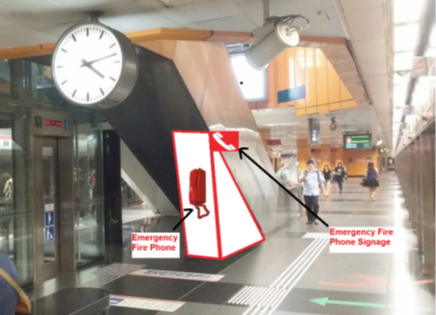Please enter a keyword to search
One and two-way emergency voice communication shall comply with requirements stipulated in SS 546 with the following exceptions.
a. Provisions of the two-way emergency voice communications system shall only be required for underground station. Locations of remote handsets for two-way emergency voice communications system shall comply with Cl.8.2.7.
b. 4-hrs backup battery capacity for the emergency voice communication system shall be provided. The backup battery capacity can be halved if it is supported by a dual feeder power supply.
Except for lift cars, one-way emergency voice communication system shall be provided throughout the station including all habitable rooms, basement floor areas, commercial spaces, escape staircases, all lobbies forming parts of the means of escape, main entrance lobby, corridors leading to exits, ancillary areas where people are working, area of refuge and assembly areas in compliance with SS 546.
The Passenger Service Centre (PSC) or in the absence of which, the Operation Control Centre (OCC) shall be able to override the one-way emergency voice communication System in the commercial spaces on commercial floor.
The sounding of the alarm bells in the ancillary areas and the commercial spaces on commercial floor can be interrupted by messages made through the one-way voice communication system. However, the alarm bells shall resume sounding not longer than 10 secs after the broadcast of messages.
The one-way emergency voice communication system shall interface with the fire alarm system in compliance with SS 546 and SS 645. When fire alarm system is activated:
a. a fire alarm sounding shall be operated for at least 15 secs with a manual or automatic switching facility provided to silence all alarm sounders. The alarm sounders shall be silenced once an alert message is being broadcast. The alert message shall be broadcast for a minimum of two cycles and continue until manually silenced or superseded manually or automatically by the evacuation message, or by a second alert message.
b. in the event of subsequent alarm activation from other alarm zones, the first emergency announcement shall be replaced by a higher priority or evacuation announcement initiated from the fire alarm system or manually from the emergency voice communication system.
c. when an emergency announcement has been initiated automatically from the fire alarm system, the first emergency announcement shall be replaced by a higher priority announcement or an evacuation announcement from the emergency voice communication system after at most 8 mins of announcement and no manual acknowledgement by the transit station operators.
Emergency fire phones (a two-way voice communication system) shall be provided in lieu of manual call points in the station public areas such that a person does not need to travel more than 90m to an emergency fire phone on any level except platform to report a fire. The PSC, where provided, can be considered as a reporting station. At platform level, emergency fire phones shall be located one on each side of the platform near or next to all the escalator landings. See Diagram 8.2.6.

Diagram 8.2.6: Location of Emergency Fire Phone
For underground station, two-way emergency voice communication shall be provided between the FCC or in the absence of which, the main alarm panel and the following:
a. Every fire lift lobby including 1st storey;
b. Fire pump room;
c. Fire lift;
d. Local manual control for smoke control equipment;
e. All lift motor rooms;
f. PSC;
g. Air-handling control rooms if a manual on/ off switch for the station’s central air-conditioning system is not provided in the PSC;
(Where AHU can be remotely monitored and controlled at the FCC, and cannot be by-passed locally, and the electrical cabling between AHU rooms and FCC are fire-rated, the two-way emergency voice communication system can be exempted.)
h. Each area of refuge; and
i. Smoke-free lobby serving firefighting staircase.
Firefighters’ intercom shall be provided for communication between the tunnel dry mains breeching inlet at the ground level and the buffer areas. The intercom unit at the buffer areas shall be located near the access stairs at the platform leading to the track level. See Diagram 8.2.8.

Diagram 8.2.8: Locations of Firefighters' Intercom at Platform Level
Underground stations shall be provided with radio (voice and data) communication facilities capable of operating in the frequency band as allocated to SCDF and approved by authority having jurisdiction.
One-way emergency voice communication system for stations with multiple transit lines shall be designed in accordance with Cl.9.2.2.
a. In the PSC, emergency fire phones and hotline telephones which are required by the following clauses can be implemented as part of a central telephone console unit for voice communication:
(1) Cl.8.2.6
(2) Cl.8.3
(3) Cl.9.2.2a.
(4) Cl.9.2.3b.
b. Calls to the emergency fire phones and hotline telephones configured on the central telephone console shall not be blocked. The console shall not be inhibited from receiving new calls due to on-going calls.
c. Visual indication shall be provided to differentiate calls that are in-use, ringing, or on-hold.

